2023 TOYOTA 86 parking brake
[x] Cancel search: parking brakePage 345 of 449
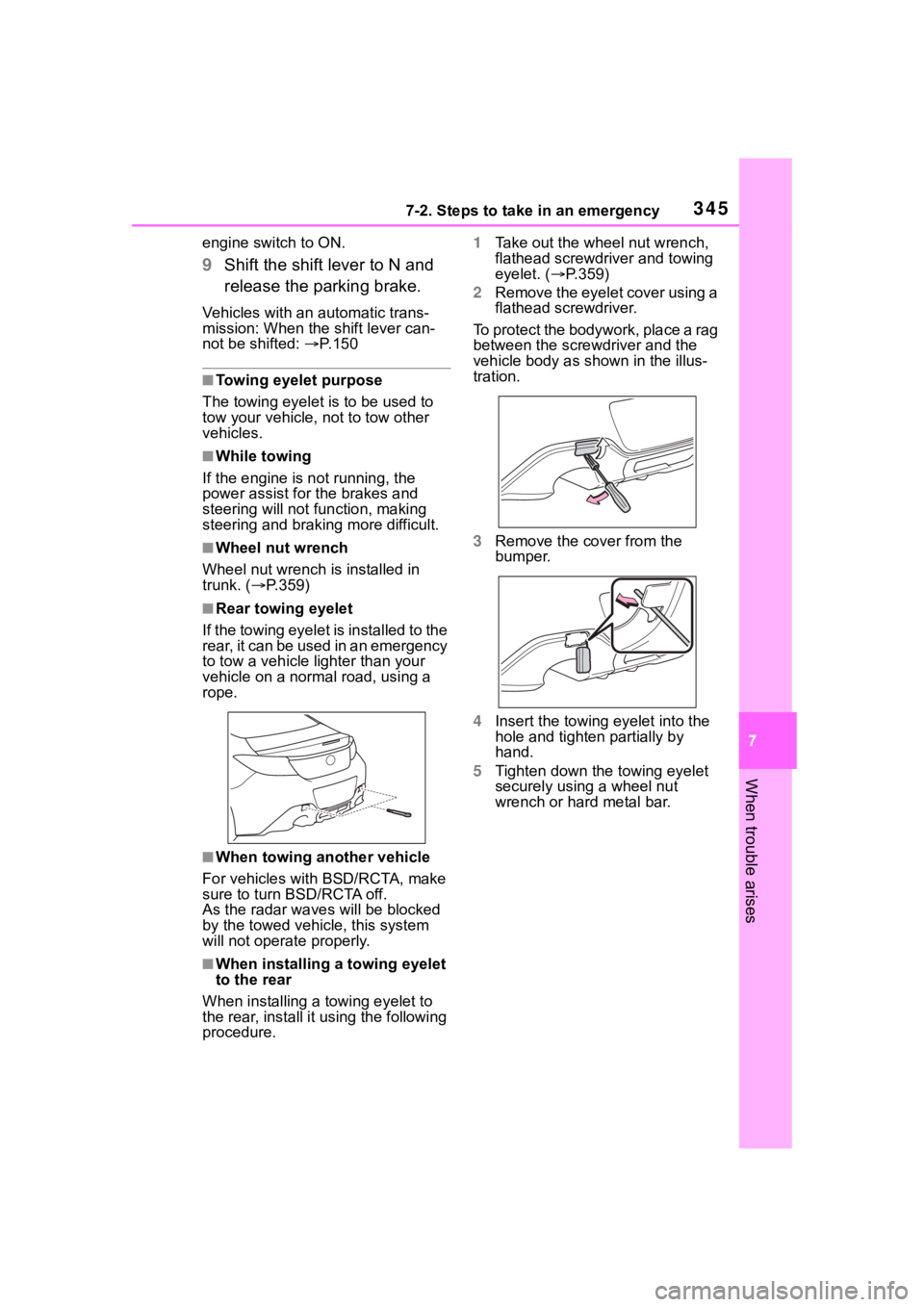
3457-2. Steps to take in an emergency
7
When trouble arises
engine switch to ON.
9Shift the shift lever to N and
release the parking brake.
Vehicles with an automatic trans-
mission: When the shift lever can-
not be shifted: P. 1 5 0
■Towing eyelet purpose
The towing eyelet i s to be used to
tow your vehicle, not to tow other
vehicles.
■While towing
If the engine is not running, the
power assist for the brakes and
steering will not function, making
steering and braking more difficult.
■Wheel nut wrench
Wheel nut wrench is installed in
trunk. ( P.359)
■Rear towing eyelet
If the towing eyelet is installed to the
rear, it can be used in an emergency
to tow a vehicle lig hter than your
vehicle on a norma l road, using a
rope.
■When towing another vehicle
For vehicles with BSD/RCTA, make
sure to turn BSD/RCTA off.
As the radar wave s will be blocked
by the towed vehicle, this system
will not operat e properly.
■When installing a towing eyelet
to the rear
When installing a towing eyelet to
the rear, install it using the following
procedure. 1
Take out the wheel nut wrench,
flathead screwdriver and towing
eyelet. ( P.359)
2 Remove the eyelet cover using a
flathead screwdriver.
To protect the bodywork, place a rag
between the screwdriver and the
vehicle body as shown in the illus-
tration.
3 Remove the cover from the
bumper.
4 Insert the towing eyelet into the
hole and tighten partially by
hand.
5 Tighten down the towing eyelet
securely using a wheel nut
wrench or hard metal bar.
Page 348 of 449
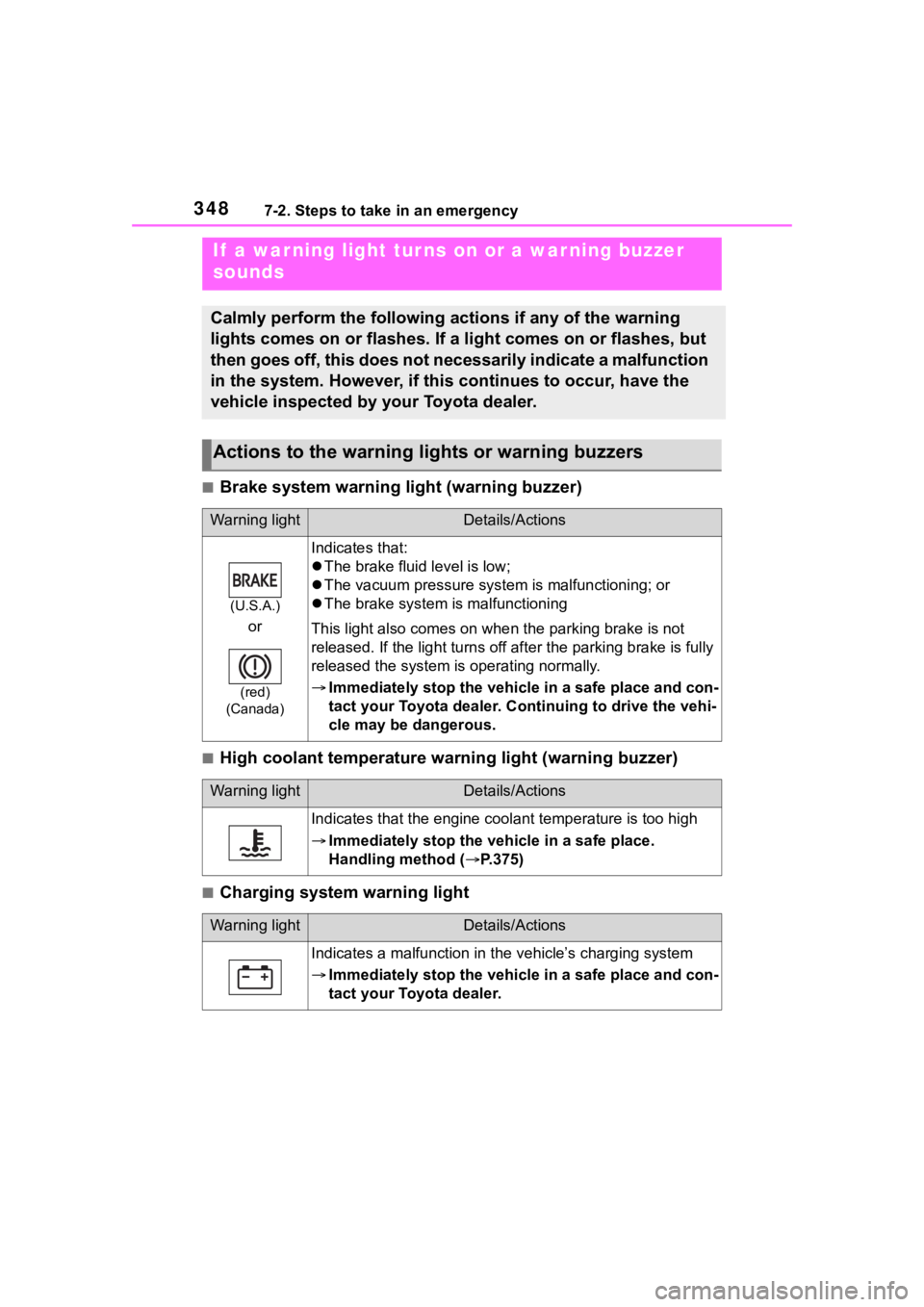
3487-2. Steps to take in an emergency
■Brake system warning light (warning buzzer)
■High coolant temperature warning light (warning buzzer)
■Charging system warning light
If a war ning light tur ns on or a war ning buzzer
sounds
Calmly perform the following actions if any of the warning
lights comes on or flashes. If a light comes on or flashes, but
then goes off, this does not necessarily indicate a malfunction
in the system. However, if this continues to occur, have the
vehicle inspected by your Toyota dealer.
Actions to the warning lights or warning buzzers
Warning lightDetails/Actions
(U.S.A.)
or
(red)
(Canada)
Indicates that:
The brake fluid level is low;
The vacuum press ure system is malfunctioning; or
The brake system is malfunctioning
This light also comes on whe n the parking brake is not
released. If the light turns off after the parking brake is ful ly
released the system is operating normally.
Immediately stop the vehicle in a safe place and con-
tact your Toyota dealer. Continuing to drive the vehi-
cle may be dangerous.
Warning lightDetails/Actions
Indicates that the engine coolant temperature is too high
Immediately stop the vehicle in a safe place.
Handling method ( P.375)
Warning lightDetails/Actions
Indicates a malfunction in the vehicle’s charging system
Immediately stop the vehicle in a safe place and con-
tact your Toyota dealer.
Page 358 of 449
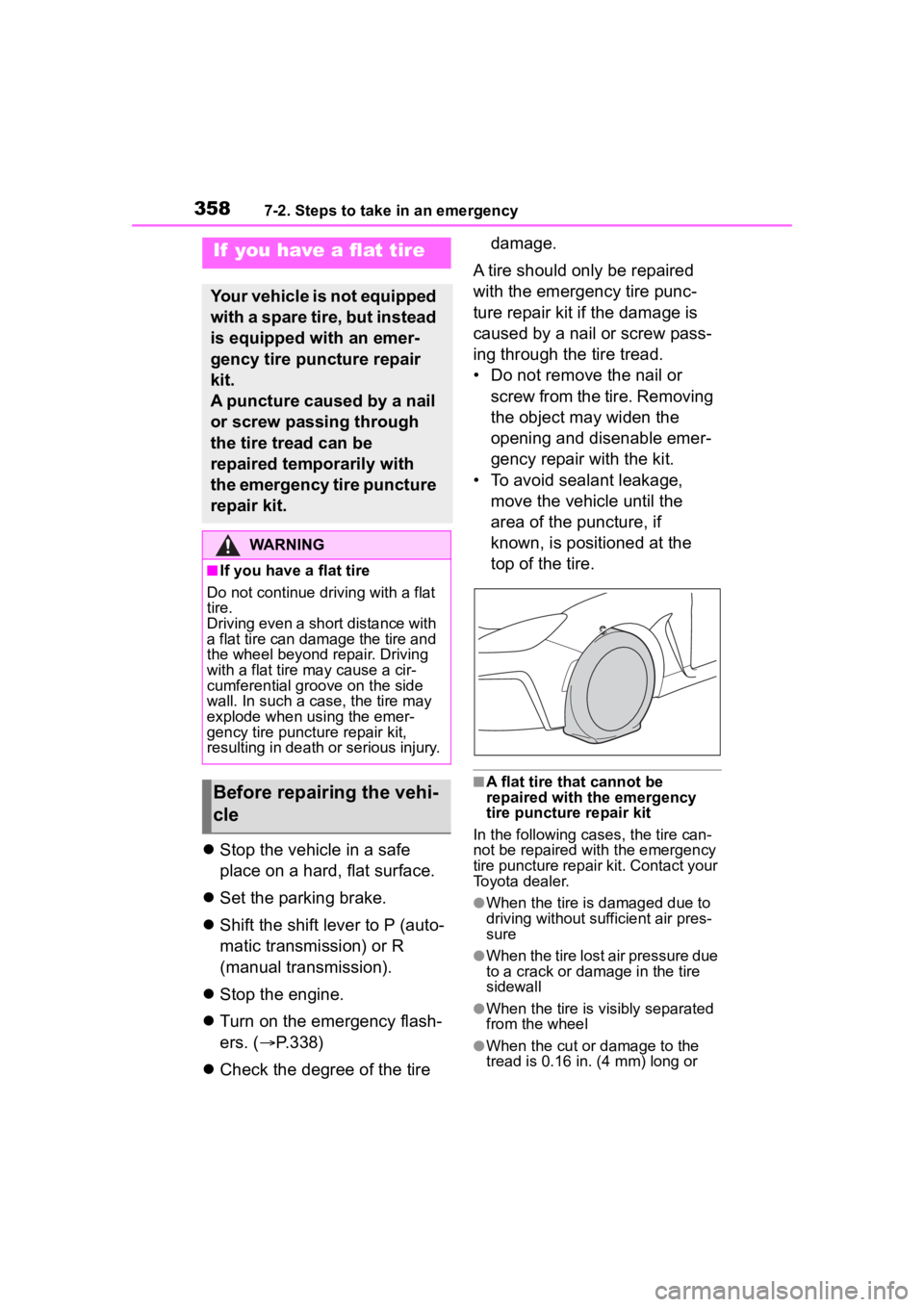
3587-2. Steps to take in an emergency
Stop the vehicle in a safe
place on a hard, flat surface.
Set the parking brake.
Shift the shift lever to P (auto-
matic transmission) or R
(manual transmission).
Stop the engine.
Turn on the emergency flash-
ers. ( P.338)
Check the degree of the tire damage.
A tire should only be repaired
with the emergency tire punc-
ture repair kit if the damage is
caused by a nail or screw pass-
ing through the tire tread.
• Do not remove the nail or screw from the tire. Removing
the object may widen the
opening and disenable emer-
gency repair with the kit.
• To avoid sealant leakage, move the vehicle until the
area of the puncture, if
known, is positioned at the
top of the tire.
■A flat tire that cannot be
repaired with the emergency
tire puncture repair kit
In the following cases, the tire can-
not be repaired with the emergency
tire puncture repair kit. Contact your
Toyota dealer.
●When the tire is damaged due to
driving without sufficient air pres-
sure
●When the tire lost air pressure due
to a crack or damage in the tire
sidewall
●When the tire is visibly separated
from the wheel
●When the cut or damage to the
tread is 0.16 in. (4 mm) long or
If you have a flat tire
Your vehicle is not equipped
with a spare tire, but instead
is equipped with an emer-
gency tire puncture repair
kit.
A puncture caused by a nail
or screw passing through
the tire tread can be
repaired temporarily with
the emergency tire puncture
repair kit.
WARNING
■If you have a flat tire
Do not continue driving with a flat
tire.
Driving even a short distance with
a flat tire can damage the tire and
the wheel beyond repair. Driving
with a flat tire may cause a cir-
cumferential groove on the side
wall. In such a case, the tire may
explode when using the emer-
gency tire puncture repair kit,
resulting in death or serious injury.
Before repairing the vehi-
cle
Page 368 of 449
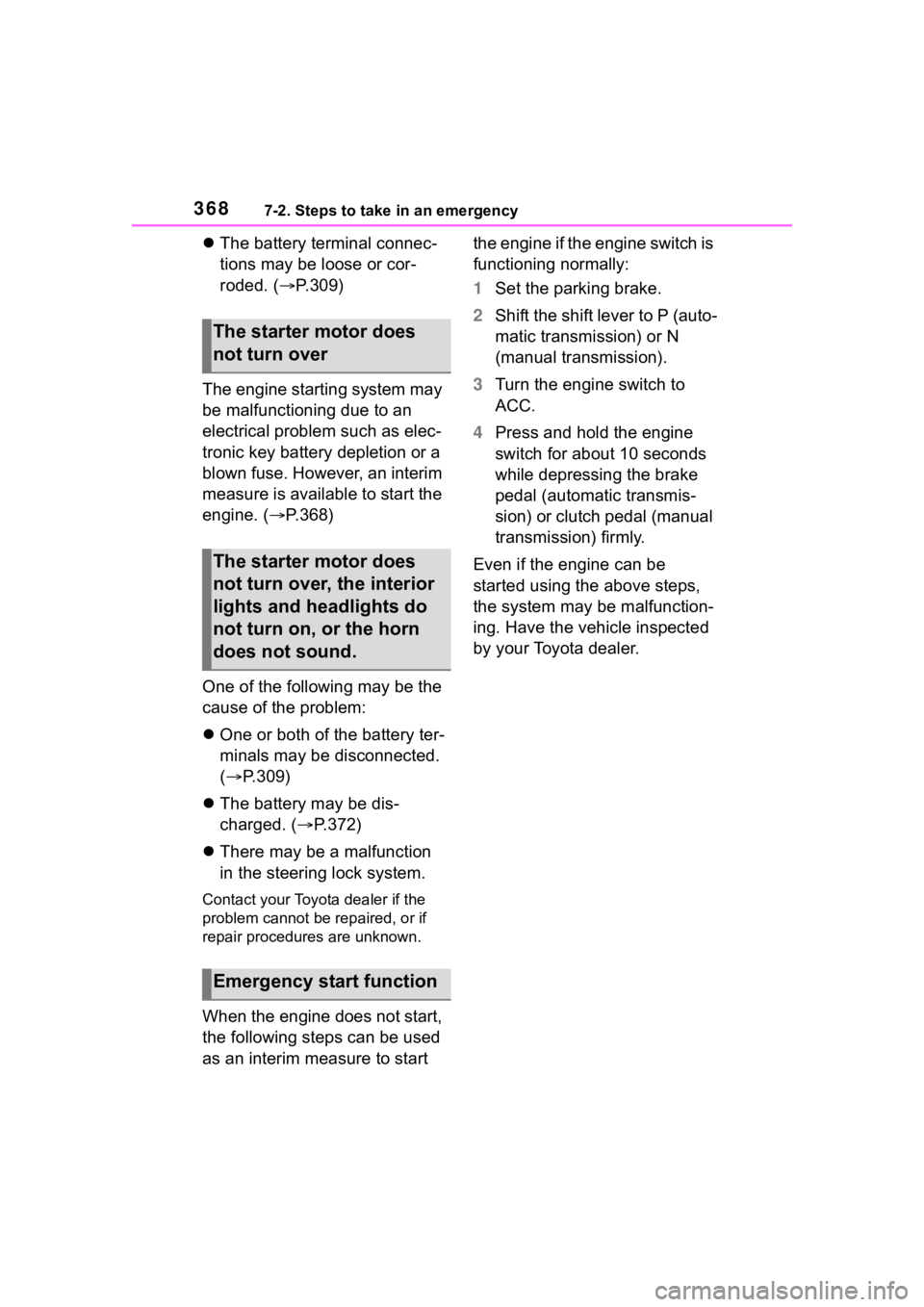
3687-2. Steps to take in an emergency
The battery terminal connec-
tions may be loose or cor-
roded. ( P.309)
The engine starting system may
be malfunctioning due to an
electrical problem such as elec-
tronic key battery depletion or a
blown fuse. However, an interim
measure is available to start the
engine. ( P.368)
One of the following may be the
cause of the problem:
One or both of the battery ter-
minals may be disconnected.
( P.309)
The battery may be dis-
charged. ( P.372)
There may be a malfunction
in the steering lock system.
Contact your Toyot a dealer if the
problem cannot be repaired, or if
repair procedures are unknown.
When the engine does not start,
the following steps can be used
as an interim measure to start the engine if the engine switch is
functioning normally:
1
Set the parking brake.
2 Shift the shift lever to P (auto-
matic transmission) or N
(manual transmission).
3 Turn the engine switch to
ACC.
4 Press and hold the engine
switch for about 10 seconds
while depressing the brake
pedal (automatic transmis-
sion) or clutch pedal (manual
transmission) firmly.
Even if the engine can be
started using the above steps,
the system may be malfunction-
ing. Have the vehicle inspected
by your Toyota dealer.
The starter motor does
not turn over
The starter motor does
not turn over, the interior
lights and headlights do
not turn on, or the horn
does not sound.
Emergency start function
Page 377 of 449
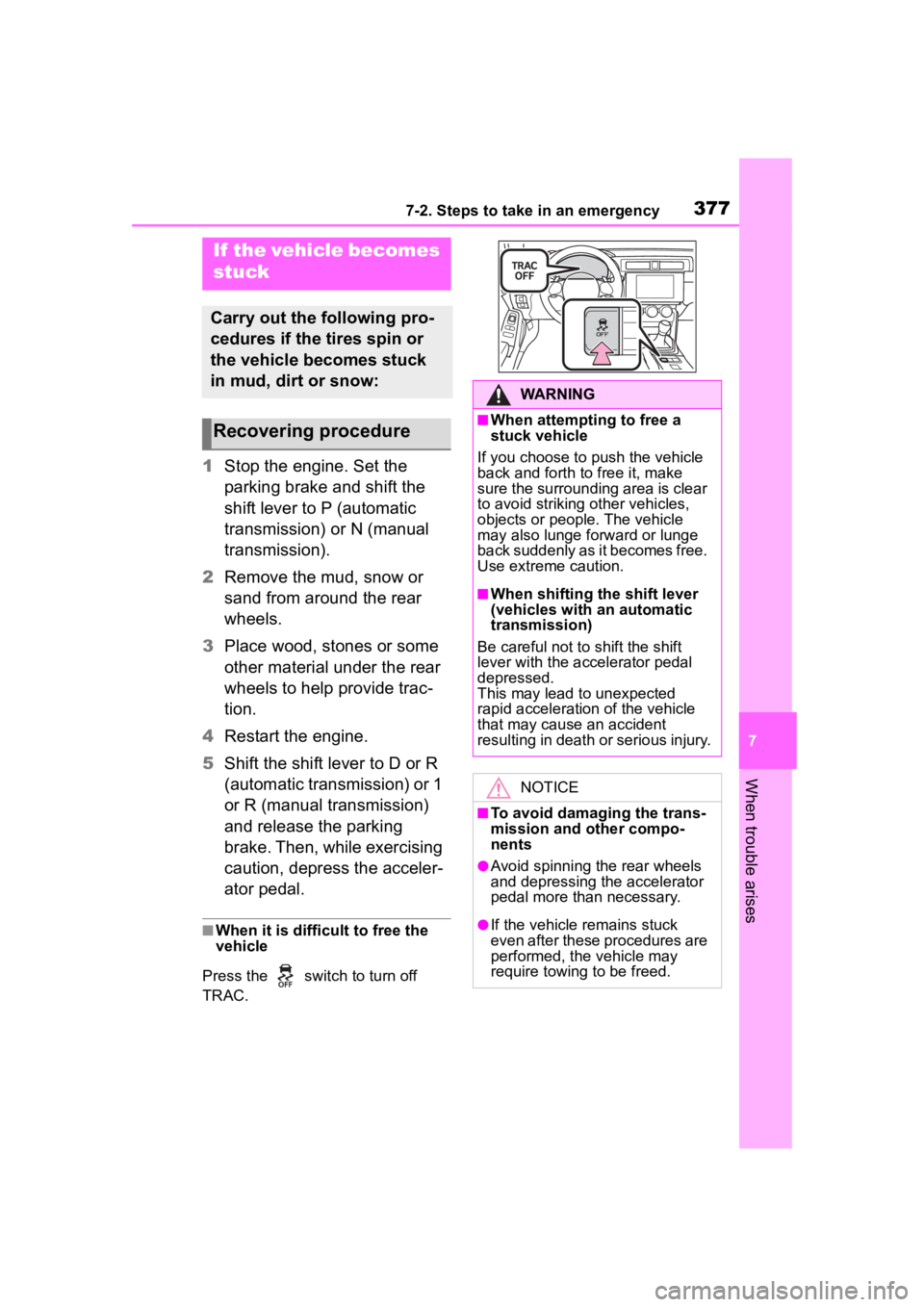
3777-2. Steps to take in an emergency
7
When trouble arises
1Stop the engine. Set the
parking brake and shift the
shift lever to P (automatic
transmission) or N (manual
transmission).
2 Remove the mud, snow or
sand from around the rear
wheels.
3 Place wood, stones or some
other material under the rear
wheels to help provide trac-
tion.
4 Restart the engine.
5 Shift the shift lever to D or R
(automatic transmission) or 1
or R (manual transmission)
and release the parking
brake. Then, while exercising
caution, depress the acceler-
ator pedal.
■When it is difficult to free the
vehicle
Press the switch to turn off
TRAC.
If the vehicle becomes
stuck
Carry out the following pro-
cedures if the tires spin or
the vehicle becomes stuck
in mud, dirt or snow:
Recovering procedure
WARNING
■When attempting to free a
stuck vehicle
If you choose to push the vehicle
back and forth to free it, make
sure the surrounding area is clear
to avoid striking other vehicles,
objects or people. The vehicle
may also lunge forward or lunge
back suddenly as it becomes free.
Use extreme caution.
■When shifting the shift lever
(vehicles with an automatic
transmission)
Be careful not to shift the shift
lever with the accelerator pedal
depressed.
This may lead to unexpected
rapid acceleration of the vehicle
that may cause an accident
resulting in death o r serious injury.
NOTICE
■To avoid damaging the trans-
mission and other compo-
nents
●Avoid spinning the rear wheels
and depressing the accelerator
pedal more than necessary.
●If the vehicle remains stuck
even after these procedures are
performed, the vehicle may
require towing to be freed.
Page 386 of 449

3868-1. Specifications
*1: Minimum pedal clearance when depressed with a force of 67 lbf (300 N,
30 kgf) while the engine is running.
Carpet
Brake pedal
Pedal clearance
*2: Parking brake lever travel when pulled up with a force of 45.0 lbf (200 N,
20.4 kgf).
Ty p e A
Brake pad wear limit
Fro nt0.06 in. (1.5 mm)
Rea r0.06 in. (1.5 mm)
Parking brake lining wear limit0.06 in. (1.5 mm)
Parking brake lever travel*27 - 8 clicks
Fluid typeSAE J1703 or FMVSS No.116 DOT 3
A
C
Steering
Free playLess than 1.2 in. (30 mm)
Tires and wheels
Tire size215/45R17 87W
Tire inflation pressure
(Recommended cold tire
inflation pressure)Front: 35 psi (240 kPa, 2.4 kgf/cm2 or bar)
Rear: 35 psi (240 kPa, 2.4 kgf/cm
2 or bar)
Wheel size17 7 1/2 J
Wheel nut torque89 ft•lbf (120 N•m, 12.2 kgf•m)
Page 427 of 449

427What to do if... (Troubleshooting)
Is the steering wheel
unlocked? ( P.145)
Is the electronic key battery
weak or depleted?
In this case, the engine can be
started in a temporary way.
( P.370)
Is the battery discharged?
( P.372)
Is the engine switch in ON?
If you cannot release the shift lever
by depressing the brake pedal with
the engine switch in ON. ( P.150)
It is locked automatically to
prevent theft of the vehicle.
( P.145)
Is the window lock switch
pressed?
The power window except for the
one at the driver’s seat cannot be
operated if the win dow lock switch
is pressed. ( P.130)
The auto power off function
will be operated if the vehicle
is left in ACC or ON (the
engine is not running) for a
period of time. ( P.148)
The seat belt reminder light is
flashing
Are the driver and the passenger
wearing the seat belts? ( P.351)
The brake system warning
light is on
Is the parking br ake released?
( P.156)
Depending on the situation,
other types of warning buzzer
may also sound. ( P.348, 357)
Did anyone inside the vehicle
open a door during setting the
alarm?
The sensor detects it and the alarm
sounds. ( P. 8 1 )
Do one of the following to deac-
tivate or stop the alarm:
Unlock the doors or open the
trunk using the entry function
or wireless remote control.
Open the trunk using the
entry function or wireless
remote control.
The shift lever cannot be
shifted from P even if you
depress the brake pedal
(Automatic transmission)
The steering wheel can-
not be turned after the
engine is stopped
The windows do not open
or close by operating the
power window switches
The engine switch is
turned off automatically
A warning buzzer sounds
during driving
An alarm is activated and
the horn sounds
Page 429 of 449

429Alphabetical Index
Alphabetical Index
A
A/CAir conditioning filter ............. 327
Automatic air conditioning sys-tem ..................................... 270
ABS (Anti-lock Brake System) ............................................... 262Warning light ........................ 349
Active Sound Control (ASC).. 157
Adaptive Cruise Control ........ 190 Warning message ................ 357
Air conditioning filter ............. 327
Air conditioning system Air conditioning filter ............. 327
Automatic air conditioning sys-tem ..................................... 270
Airbags Correct driving posture ........... 23
Front passenger occupant clas-sification system ................... 56
Locations of airbags ............... 29
SRS airbags ........................... 29
SRS warning light................. 349
Alarm ......................................... 81 Warning buzzer .................... 348
Anchor brackets ................. 66, 73
Antennas (smart key system) 111
Anti-lock Brake System (ABS) ............................................... 262Warning light ........................ 349
ASC (Active Sound Control).. 157
Audio system-linked display ... 98
Automatic air conditioning sys- tem ......................................... 270
Automatic headlight leveling system ................................... 159
Automatic light control system ............................................... 159
Automatic transmission ........ 149 Manual mode ....................... 152
Paddle shift switches.... 151, 152 Auxiliary box ...........................282
Auxiliary boxes .......................281
Average fuel consumption ......94
Average vehicle speed .............94
B
Back-up light
Replacing light bulbs ............334
Wattage ................................387
Battery Battery checking ...................309
If the battery is d ischarged ...372
Preparing and checking before winter ..................................266
Warning light.........................348
Blind Spot Detection (BSD) ...232
Bottle holders .........................280
Brake Fluid......................................385
Parking brake .......................156
Warning light.........................348
Brake assist ............................262
Break-in tips ............................133
Brightness control Instrument panel light control .91
BSD (Blind Spot D etection) ...232
C
Camera
High Beam Assist system .....162
Care Exterior .................................288
Interior ..........................291, 293
Seat belts .............................291
Ultrasuede
®..........................293
Wheels and wheel ornaments ...........................................288
Cargo capacity ........................143
Chains......................................268
Child restraint system Fixed with a LATCH system ...71